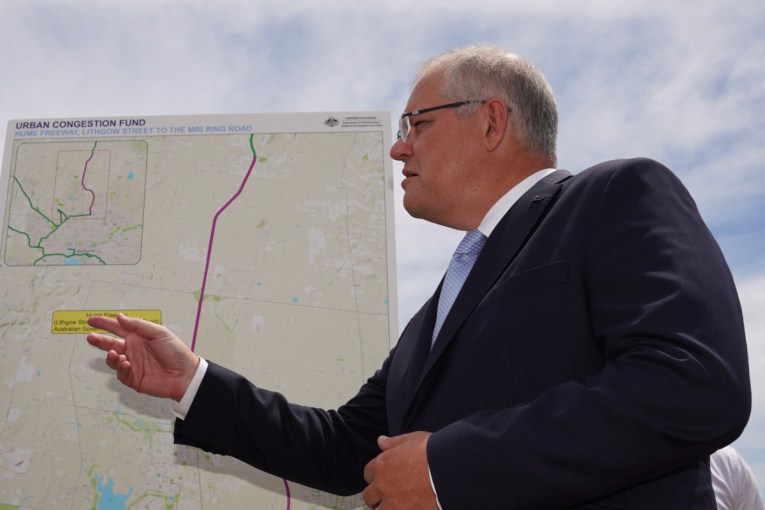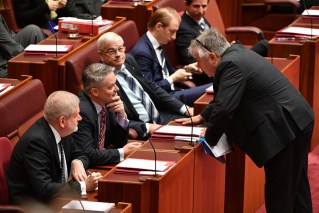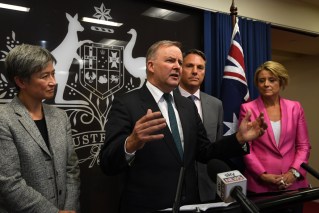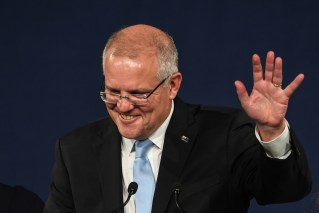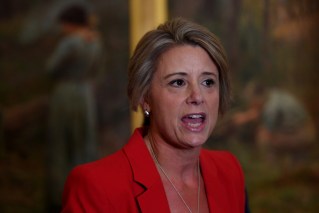No legislation, no tax cuts: Treasury firm on July 1 deadline


A carrot for voters? The PM says yes, but Treasury says unlikely. Photo: AAP
Australian workers earning under $130,000 won’t get the $1080 lump sum tax refund they have been promised for July 1 unless it can be legislated, Treasury has confirmed.
Both parties support the measure, meaning that it will be adopted once it passes Parliament.
But the Pre-Election Economic and Fiscal Outlook (PEFO), released on Wednesday, has again raised concerns that the clock is ticking on whether the tax cuts can be delivered immediately – contrary to Prime Minister Scott Morrison’s claims they will come into force on July 1.
Parliament faces a tight time frame to finalise the tax refunds – which are supported by the Labor Party – because they were not legislated before it rose before the election.
PEFO also confirms the budget deficit for 2018-19 has increased from $4.3 billion because of the decision to extend the $75 energy rebate to Newstart and other welfare recipients, at a cost of more than $80 million.
But overall, the outlook, as expected, has not “materially changed” since the April 2 budget.
The New Daily reported on April 8 that the Australian Tax Office had confirmed that, because the $1080 will be paid as a lump sum, it cannot put systems in place to deliver it before legislation passing Parliament, as it has done previously.
In a “statement of risk” included in the PEFO, Treasury and Finance has again raised this issue. It is in a section dealing with unlegislated measures, including the $1080 refund.
“Where legislation is not passed in time to enable commencement at that date, is passed with amendments to the original decision, or is rejected, there is a risk of a variation to the fiscal position outlined in the PEFO,” the document states.
“There are a number of tax measures included in the 2019-20 budget that take effect on or before 1 July 2019. Many of these measures can be legislated at a later time within 2019-20 without materially affecting the estimates.
“However, the immediate relief to low- and middle-income earners component of the Lower Taxes for Hard-Working Australians: Building on the Personal Income Tax Plan measure requires the relevant legislation to be passed before the increase to the low- and middle-income tax offset can be provided for the 2018-19 financial year. If not legislated prior to 1 July 2019, the revenue cost of this measure would need to be reassessed.”
Despite the PEFO warning, the Prime Minister again raised on Wednesday the past practice of delivering the tax cuts administratively when questioned by reporters on the campaign trail in Tasmania.
“What happens traditionally with the tax office is, where there is a bipartisan commitment to matters, that they can often go ahead and admit the tax arrangements on that basis,” Mr Morrison said.
“There are measures they’ve been able to do that. It is our intention to legislate them.
“As we were successful last time, we will be successful again.”
But the ATO appeared to rule out this option in a statement to The New Daily on April 8: “The measures announced as part of the 2019-20 budget are subject to receiving royal assent and are not yet law,” the ATO spokesman said.
“The ATO requires law in order to deliver the measure as announced, and, as such, it cannot be delivered administratively.”
PEFO finds forecast 2018-19 budget deficit is $4.3 billion
PEFO finds that the “economic and fiscal outlook for the Commonwealth has not materially changed since the publication of the 2019-20 Budget on 2 April 2019”.
“An underlying cash surplus of $7.1 billion (0.4 per cent of GDP) is expected in 2019-20, with further surpluses expected across the forward estimates,” the document states.
The pre-election sweetener for the energy supplement – $75 for singles and $125 for couples – has slightly increased the deficit.
“Policy decisions taken since the 2019-20 Budget have had a negative underlying cash balance impact of $93 million in 2018-19 and $3 million over the four years to 2022-23. This primarily reflects the decision to extend the Energy Assistance Payment to additional welfare payments, which is expected to increase payments by $88 million in 2018-19,” PEFO states.
“Real GDP is forecast to grow at around its estimated potential rate of 2¾ per cent in 2019-20 and 2020-21, sustaining solid employment growth and supporting a pick-up in wage growth.
PEFO also wants that there is “uncertainty about the outlook for the housing market”.
“In particular, the extent to which housing prices fall further, poses a downside risk to the outlook for both dwelling investment and consumption,” it states.
“A more subdued outlook for household income, or a further tightening in credit conditions, could also constrain household spending amid high levels of household debt.
“Price falls have been largest in Sydney and Melbourne over that period, although prices remain around 40 to 50 per cent higher in those cities relative to their 2012 levels.
Nominal GDP is forecast to grow by 5 per cent in 2018-19, 3¼ per cent in 2019-20 and 3¾ per cent in 2020-21.
This year’s PEFO is unusual because it is being released so close to the budget that was handed down on April 2.
Generally, federal election are more often held towards the end of the year, which means there is more likely to be material differences between the economic outlook data released in the budget, which is traditionally released in May.
Labor also seized on the results to highlight the Grattan Institute’s analysis indicating that the commonwealth government’s projections require a cut to spending of about $40 billion a year by 2029-30.
The PM has dismissed the Grattan Institute analysis as “absolute, complete rubbish”.
